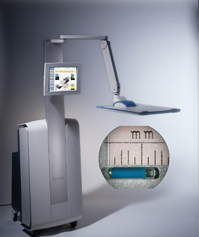by
Brendon Nafziger, DOTmed News Associate Editor | November 12, 2009

Siemens' linear accelerator
could feature Calypso's
real-time tumor-tracking technology
Calypso Medical recently reached an agreement with German medical equipment giant Siemens to develop linear accelerators featuring the nine-year-old, Seattle-Wash.-based company's real-time tumor tracking system.
Images of the work-in-progress device were on hand at the American Society for Radiation Oncology (ASTRO) meeting earlier this month, as was a working model of Varian Medical Systems' linear accelerator that also employs Calypso's GPS-based technology.
The new system uses a dynamic multi-leaf collimator that changes the shape of the beam to track the tumor, compensating for tumor movement from patient breathing or the natural motion of fluids and gases in the body. As a fail safe, the system is set to automatically shut off once the radiation beam strays from the exact vicinity of the lesion, thereby ensuring that healthy tissue is spared radiation damage.



Ad Statistics
Times Displayed: 797
Times Visited: 5 Keep biomedical devices ready to go, so care teams can be ready to care for patients. GE HealthCare’s ReadySee™ helps overcome frustrations due to lack of network and device visibility, manual troubleshooting, and downtime.
"It's a closed-loop system to do real-time tumor chasing, so you can adjust your treatment beam on the fly based on tumor position," Edward Vertatschitsch, Ph.D., senior vice president of operations at Calypso, tells DOTmed News.
Or, as Calypso CEO and co-founder Eric Meier puts it, "When you're in the 'strike zone' you treat, when you're outside the 'strike zone,' you don't treat."
While not available yet, the technology showcased at ASTRO is under independent investigation by researchers at the German Cancer Research Center in Heidelberg, as well as at Stanford University in Palo Alto, Calif.
But the tumor-tracking depends on Calypso's "GPS for the body" system which is currently installed at several cancer centers across the country, such as Cleveland Clinic and the Memorial Sloan-Kettering Cancer Center. The system, so far only approved for use on the prostate and the prostate bed, works by inserting three tiny magnetic transponders, each about the size of a grain of sand, through a biopsy-like procedure into the tumor or surrounding area. The system then beams electromagnetic energy to activate the transponders which then respond, giving the exact location of the tumor with submillimeter accuracy.
"It allows more precisely delivered treatment," Dr. Vertatschitsch says. "With greater accuracy and precision, you can increase dose escalation, potentially shortening the number of treatment sessions. This is all predicated on greater confidence of knowing the tumor position."
While it's only FDA-cleared for the prostate, Calypso is hoping to have it available for the pancreas and other areas soon.
"We're taking a stepwise approach," says Dr. Vertatschitsch, "It's a very deliberate marketing decision, making unique and specific claims for different body sites, and prostate was the first."
Back to HCB News

